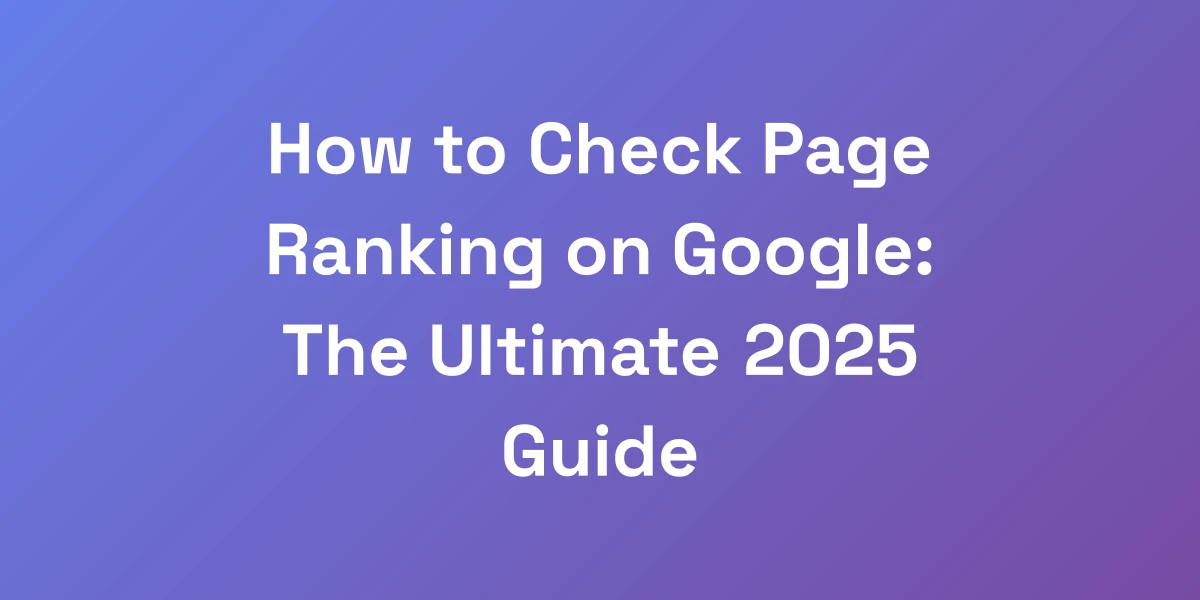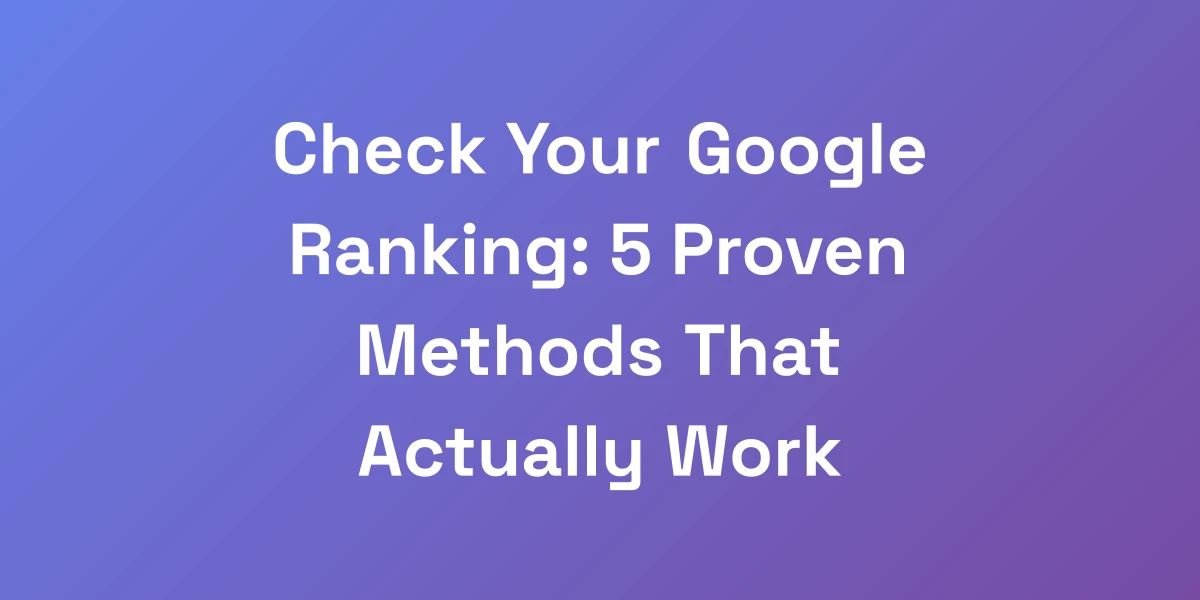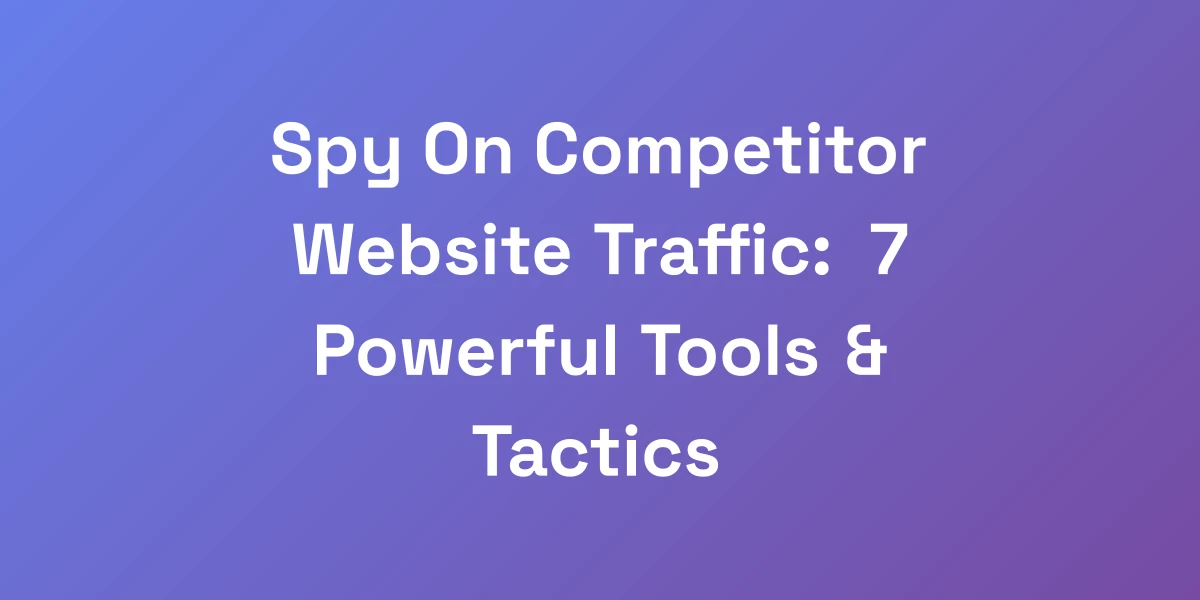
How to Check Website Position in Google: 5 Powerful Free Methods
Mar 17, 2025 | By [email protected]
Introduction
We’ve got a problem. You’re hustling day in and day out, putting every ounce of effort into your website, yet you’re flying blind when it comes to understanding where you stand in Google’s rankings. It’s frustrating, right? Especially when 93% of online experiences begin with search engines. The traditional methods you’ve been relying on to check your website’s position are not just outdated—they’re costing you money.
Imagine this: you’re investing time and resources into SEO, but without accurate rank tracking, you’re essentially throwing darts in the dark. The rules have changed since 2020, and what worked back then is now obsolete. But don’t worry, we’re here to turn things around. In this article, we’re diving deep into five powerful, free methods to check your website’s position on Google. These aren’t your run-of-the-mill tools; these are the game-changers that will give you precise ranking data in seconds, not hours. Ready to level up your SEO game? Let’s get started.
Why Traditional Website Ranking Methods Are Dead Wrong
Listen, we’re not here to sugarcoat things. If you’re still manually searching Google in incognito mode to check your rankings, you’re leaving serious money on the table.
The landscape has evolved. SEO today demands precision, speed, and adaptability. Let’s break down why those old-school methods just don’t cut it anymore.
The Fatal Flaws of Manual Rank Checking
Manual rank checking might sound straightforward, but it’s riddled with inefficiencies and inaccuracies. Here’s why:
- Time-Consuming: Imagine checking each keyword individually. It’s a tedious process that eats up valuable time.
- Inconsistent Results: Human error is inevitable. Missing a day or two can skew your data significantly.
- Lack of Historical Data: Without consistent tracking, understanding trends over time is nearly impossible.
These flaws mean you’re never getting the full picture. It’s like trying to assemble a puzzle with missing pieces.
Why Personalized Search Results Skew Your Data
Personalization is Google’s way of tailoring personalized search results to individual users. While it’s great for user experience, it complicates rank tracking.
- Location Variance: Your rankings can differ based on where the search is conducted.
- User Behavior: Previous searches and interactions influence what you see, making it hard to get a neutral ranking.
With the November 2024 Core Update, personalization has become even more pronounced, increasing rank variance and making manual checks even less reliable.
The Real Cost of Inaccurate Ranking Data
Inaccurate ranking data isn’t just a minor inconvenience—it’s a direct hit to your bottom line.
- Missed Opportunities: Without precise data, you can’t identify which keywords are driving traffic and conversions.
- Wasted Resources: Investing in the wrong strategies based on faulty data is a recipe for failure.
- Competitive Disadvantage: Your competitors are likely using advanced tools. Falling behind means losing market share.
It’s not just about knowing where you rank; it’s about understanding how those rankings impact your business.
Modern Ranking Factors You Need to Track
SEO has matured, and so have the factors that influence rankings. Here’s what you need to be tracking now:
- Mobile vs. Desktop Rankings: With over 58.7% of global traffic coming from mobile vs desktop usage, understanding device-specific rankings is crucial.
- Search Intent: Google is getting smarter at understanding what users are really searching for.
- Content Quality: The March 2024 Google search algorithm updates emphasize high-quality, original content.
- Backlink Profiles: Quality over quantity is the name of the game when it comes to backlinks.
- Page Speed: Faster websites provide better user experiences and rank higher.
Tracking these factors gives you a holistic view of your SEO performance and helps you make informed decisions.
The Ultimate Google Search Console Strategy for Rank Tracking
Here’s the truth that most “experts” won’t tell you: Google Search Console is the most powerful free ranking tool you already have access to. It’s straight from the source—Google itself. But 99% of website owners are using it wrong. Let’s change that.
We’re diving deep into how to leverage Google Search Console to extract golden ranking data that most people don’t even know exists. These aren’t just tips—they’re the same techniques that helped grow multiple 8-figure businesses by dominating search rankings.
Setting Up Google Search Console Like a Pro
First things first, if you haven’t set up Google Search Console (GSC) correctly, you’re missing out. Here’s how to do it right:
- Verify Your Site: Ensure your website is verified through DNS, HTML file upload, or Google Analytics.
- Sitemap Submission: Submit your sitemap to help Google crawl and index your site efficiently.
- Mobile Usability: Check the mobile usability report to fix any mobile-specific issues.
Proper setup ensures that you’re capturing all the data you need for accurate rank tracking.
Advanced Performance Report Techniques
GSC’s Performance report is a goldmine if you know how to use it.
- Filter by Query: Focus on specific keywords to see detailed performance metrics.
- Analyze Click-Through Rates (CTR): Higher CTRs can indicate more effective titles and meta descriptions.
- Impressions vs. Clicks: Understanding the gap between impressions and clicks helps identify ranking opportunities.
These techniques provide a deeper understanding of how your keywords are performing and where there’s room for improvement.
Custom Filters for Accurate Ranking Data
Custom filters allow you to segment your data for more precise insights.
- Device Type: Separate data for mobile and desktop to understand device-specific performance.
- Geographic Location: Filter by country or region to see where you’re performing best.
- Date Range: Compare different time periods to spot trends and seasonality.
Using custom filters helps you tailor your analysis to your specific needs, providing more actionable data.
Tracking Historical Position Changes
Understanding how your rankings are more volatile over time is crucial for long-term SEO strategy.
- Regular Reporting: Schedule monthly reports to track progress and identify trends.
- Identify Fluctuations: Spot sudden drops or gains to understand what’s driving changes.
- Correlate with Updates: Align ranking changes with Google updates to see their impact.
Historical tracking helps you make data-driven decisions and adjust your strategies as needed.
Export and Analysis Strategies
Exporting your data from GSC allows for deeper analysis and integration with other tools.
- BigQuery Integration: For advanced users, integrating GSC with Google BigQuery can unlock powerful data analysis capabilities.
- Spreadsheet Analysis: Use Excel or Google Sheets to manipulate and visualize your data.
- Automated Dashboards: Create dashboards to monitor key metrics in real-time.
Exporting data ensures you’re not limited by GSC’s interface and can perform the analysis that you need.
For a visual guide on setting up data exports, check out this YouTube video tutorial.
Free Rank Checking Tools That Actually Work in 2025
Stop wasting time with outdated tools that give you yesterday’s data. We’ve tested over 50 ranking tools, and we’re sharing the only ones worth your time. These aren’t just any tools—they’re the exact same tools that generate millions in revenue for our clients. Best part? They’re completely free. No credit card required, no “free trial” nonsense. Just pure, actionable ranking data and SEO tools for agencies that you can use to crush your competition.
Top 3 Most Accurate Free Rank Checkers
- SEO Review Tools’ Backlinko’s website rank checker: Great for a basic snapshot of keyword rankings. While it lacks in-depth insights, it’s a solid starting point.
- KeywordTools.Org Ranking Check Tool: Provides accurate data and a basic SERP overview, making it dependable for simple rank checks.
- Accuranker (Free Trial): Offers precise location-specific keyword positions and integrates with Google Search Console and Analytics. Ideal for detailed analysis during the trial period.
These tools offer reliable data without costing you a dime, making them perfect for startups and small businesses.
Speed vs. Accuracy: Finding the Perfect Balance
When it comes to rank checkers, you need both speed and accuracy. Fast data allows you to make timely decisions, while accuracy ensures those decisions are based on reliable information.
- SEO Review Tools: Fast but not the most accurate. Use it for quick checks.
- KeywordTools.Org: Balances speed and accuracy well for most users.
- Accuranker: Highly accurate but may take slightly longer due to its detailed nature.
Choose the tool that best fits your needs based on the importance of speed versus accuracy in your strategy.
Mobile vs. Desktop Ranking Differences
Understanding the differences between mobile and desktop rankings is essential in today’s mobile-first world.
- Mobile Usability: Mobile-friendly sites rank higher on mobile searches. GSC can help identify these issues.
- User Behavior: Mobile users tend to engage differently, impacting rankings based on user experience.
- Responsive Design: Ensuring your site adapts seamlessly across devices can boost your overall rankings.
Regularly checking both mobile and desktop rankings ensures you’re not missing out on valuable traffic from either platform.
Location-Based Ranking Analysis
Your website’s performance can vary significantly based on geographic location. Here’s how to effectively analyze location-based rankings:
- Geo-Specific Keywords: Track keywords that are relevant to specific locations to understand local performance.
- Regional Trends: Analyze how different regions engage with your content and adjust your strategy accordingly.
- Competitor Analysis: See how you stack up against local competitors in different areas.
Tailoring your SEO efforts to geographic insights can drive more targeted traffic and increase your local market share.
Bulk Keyword Position Checking
Managing a large number of keywords can be overwhelming, but bulk keyword position checking makes it manageable.
- Efficiency: Check the rankings of multiple keywords simultaneously, saving time and effort.
- Comprehensive Insights: Get a holistic view of your keyword performance in one go.
- Batch Analysis: Identify patterns and opportunities across your entire keyword portfolio.
Bulk checking tools streamline your SEO workflow, allowing you to focus on optimizing your strategies rather than managing data.
Advanced Rank Tracking Automation Systems
Want to know what separates six-figure websites from seven-figure empires? Automation. We’re going to show you how to build a completely automated ranking tracking system that will notify you of any position changes in real-time. This isn’t just about saving time—it’s about catching opportunities before your competition even knows they exist. We’re talking about turning ranking data into revenue on autopilot.
Setting Up Automated Rank Tracking
Automation is the key to staying ahead. Here’s how to set up a seamless automated rank tracking system:
- Select the Right Tools: Choose tools that offer automation features, such as rank checker tools and SEO checklist like KeywordTools.Org and Accuranker.
- Define Your Keywords: Identify and prioritize the keywords that matter most to your business.
- Schedule Regular Updates: Automate regular checks to keep your data fresh and actionable.
An automated system ensures you’re always in the loop without the manual hassle.
Creating Custom Ranking Alerts
Custom alerts keep you informed about significant changes in your rankings. Here’s how to set them up effectively:
- Thresholds for Alerts: Define specific criteria, such as drops or gains of 5 positions, to trigger alerts.
- Notification Channels: Choose how you want to receive alerts—email, SMS, or through your dashboard.
- Actionable Triggers: Set up alerts for critical keywords that directly impact your business goals.
Custom alerts ensure you can act quickly on significant ranking changes, maintaining your competitive edge.
API Integration for Real-Time Data
Integrating APIs can elevate your rank tracking to a whole new level. Here’s how:
- Google Search Console API: Access detailed search performance data programmatically.
- SEMrush and Ahrefs APIs: Retrieve comprehensive SEO metrics and integrate them with your systems.
- Real-Time Dashboards: Use APIs to feed data into dashboards for instant, real-time insights.
API integration ensures your rank tracking is not only automated but also seamlessly integrated into your existing workflows.
Competitor Position Monitoring
Knowing where your competitors stand can provide invaluable insights. Here’s how to effectively monitor their rankings:
- Identify Key Competitors: List out your main competitors and their target keywords.
- Track Their Performance: Use rank tracking tools to monitor their keyword positions regularly.
- Analyze Their Strategies: Understand their SEO tactics by studying their content and backlink profiles.
Staying informed about your competitors’ rankings allows you to strategically counter their moves and capitalize on their weaknesses.
Automated Reporting Systems
Consistent reporting keeps your team informed and aligned. Here’s how to set up automated reporting:
- Define Key Metrics: Choose the metrics that matter most, such as keyword rankings, organic traffic, and CTR.
- Schedule Regular Reports: Automate weekly or monthly reports to keep everyone updated.
- Visualize Data: Use charts and graphs for easy digestion of complex data.
Automated reporting systems ensure that your team always has access to the latest data without lifting a finger.
Leveraging Ranking Data for Rapid SEO Growth
Here’s where the rubber meets the road. Having ranking data is one thing—knowing how to use it to multiply your traffic and revenue is another. We’re going to reveal our exact process for turning ranking data into actionable insights that drive real business growth. This is the same system that helped our clients generate over $100 million in combined revenue last year alone. It’s not about the tools—it’s about the strategy behind using them.
Pattern Recognition in Ranking Data
Identifying patterns in your ranking data can reveal significant opportunities and potential pitfalls.
- Seasonal Trends: Recognize when certain keywords perform better and adjust your content strategy accordingly.
- Ranking Fluctuations: Spot irregular changes that could indicate underlying issues or emerging opportunities.
- Performance Correlation: Link ranking changes to specific actions, such as content updates or backlink acquisitions.
Recognizing these patterns allows you to make proactive adjustments to your SEO strategy, staying ahead of the curve.
Competitive Gap Analysis
Understanding where you stand compared to your competitors is crucial for strategic planning.
- Identify Gaps: Find keywords where your competitors rank higher and develop strategies to improve your position.
- Opportunistic Keywords: Discover keywords your competitors aren’t targeting and capitalize on them.
- Benchmarking: Regularly benchmark your performance against industry leaders to set realistic goals.
Gap analysis provides a clear roadmap for where to focus your SEO efforts to outpace your competitors.
Content Optimization Based on Rankings
Your content is your storefront on the web. Here’s how to optimize it based on ranking data:
- Identify Top Performers: Focus on optimizing content that already ranks well to push it to the top.
- Revamp Underperforming Pages: Analyze why certain pages aren’t ranking and make necessary improvements.
- Keyword Integration: Ensure that your top keywords are seamlessly integrated into your content for maximum impact.
By optimizing content based on targeted rankings, you can significantly boost your visibility and engagement.
ROI Calculation from Position Changes
Understanding the return on investment (ROI) from your SEO efforts is crucial for justifying and refining your strategies.
- Traffic to Revenue: Calculate how changes in rankings translate to increased traffic and subsequent revenue.
- Cost-Benefit Analysis: Compare the costs of your SEO tools and efforts against the revenue generated from improved rankings.
- Performance Metrics: Use metrics like conversion rates and average order value to determine the true impact of your SEO improvements.
ROI calculations help you understand the financial benefits of your SEO efforts, guiding future investments and strategies.
Future-Proofing Your Rankings
The SEO landscape is ever-changing. Here’s how to ensure your rankings remain stable and continue to grow:
- Continuous Monitoring: Regularly track your rankings and stay updated with Google’s algorithm changes.
- Adaptable Strategies: Be prepared to pivot your SEO strategies based on new trends and data insights.
- Long-Term Content Planning: Develop content that remains relevant and valuable over time, supporting sustained rankings.
Future-proofing your rankings ensures that your SEO efforts remain effective in the long run, securing your position at the top.
Conclusion
We’ve covered a lot of ground, and the takeaway is clear: traditional rank checking methods are obsolete and costly. By leveraging tools like Google Search Console and integrating advanced rank tracking systems, you can gain precise, actionable insights that drive real business growth.
Don’t let outdated practices hold you back. Embrace these free, powerful methods to check your website’s position on Google and turn your ranking data into a revenue-generating machine. Ready to dominate the search rankings? Start implementing these strategies today and watch your SEO efforts pay off.
Have questions or want to share your success stories? Drop a comment below or reach out to us on social media. Let’s crush the competition together!








